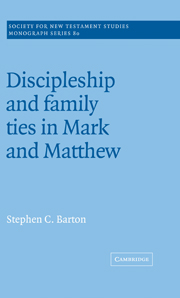Book contents
2 - The subordination of family ties in Judaism and in the Greco-Roman world of the first century
Published online by Cambridge University Press: 15 October 2009
Summary
Introduction
The gospel traditions provide clear evidence of a demand for, and an acceptance of, the subordination of family and household ties as a consequence of becoming a follower of Jesus. The detailed discussion of the evidence of the Gospels of Mark and Matthew will constitute the third and fourth chapters of the study. The kinds of question we ask in this second chapter are questions of historical context: how familiar to potential converts would the idea of the subordination of household ties have been, and how was such an idea viewed? Was it a common idea or a novel one? Whether common or novel, on what grounds was it justified? Were members of one society and tradition more likely to advocate such an idea than members of another? The main aim of the chapter is to show that the subordination of family ties to which early Christian sources like Mark and Matthew bear witness was not unprecedented in the traditions and practices of either Judaism or of the Greco-Roman world as a whole. To show this, it is not necessary to attempt an exhaustive survey. Rather, in what follows, I have chosen to focus on a selection of pertinent Jewish and Greco-Roman sources from the pre-Christian and early Christian period.
- Type
- Chapter
- Information
- Discipleship and Family Ties in Mark and Matthew , pp. 23 - 56Publisher: Cambridge University PressPrint publication year: 1994
- 1
- Cited by

